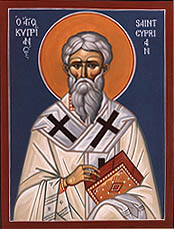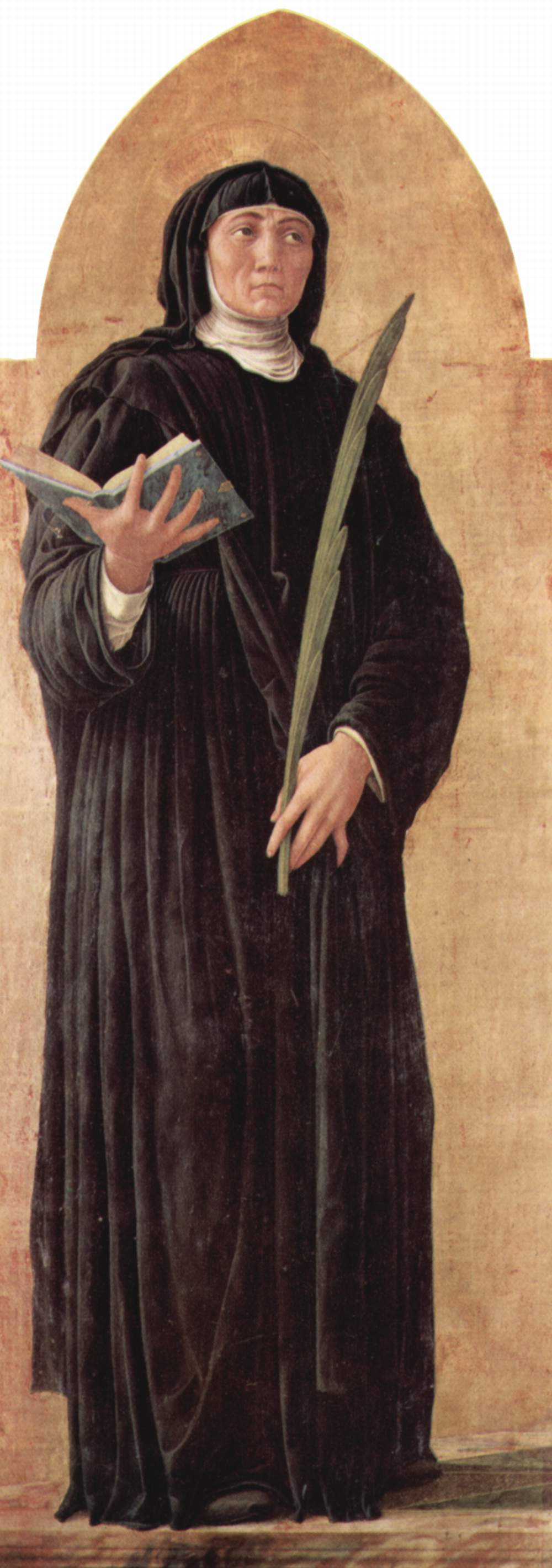|
Rita Of Cascia
Rita of Cascia, born Margherita Lotti (1381 – 22 May 1457), was an Italian widow and Augustinian nun venerated as a saint in the Roman Catholic Church. After Rita's husband died, she joined an Augustinian community of religious sisters, where she was known both for practicing mortification of the flesh and for the efficacy of her prayers. Various miracles are attributed to her intercession, and she is often portrayed with a bleeding wound on her forehead, which is understood to indicate a partial stigmata. Pope Leo XIII canonized Rita on 24 May 1900. Her feast day is celebrated on 22 May. At her canonization ceremony, she was bestowed the title of ''Patroness of Impossible Causes'', while in many Catholic countries, Rita came to be known as the patroness of abused wives and heartbroken women. Her incorrupt body remains in the Basilica of Santa Rita da Cascia. Early life Margherita Lotti was born in 1381 in the city of Roccaporena, a small suburb of Cascia (nea ... [...More Info...] [...Related Items...] OR: [Wikipedia] [Google] [Baidu] |
Saint
In religious belief, a saint is a person who is recognized as having an exceptional degree of holiness, likeness, or closeness to God. However, the use of the term ''saint'' depends on the context and denomination. In Catholic, Eastern Orthodox, Anglican, Oriental Orthodox, and Lutheran doctrine, all of their faithful deceased in Heaven are considered to be saints, but some are considered worthy of greater honor or emulation. Official ecclesiastical recognition, and consequently a public cult of veneration, is conferred on some denominational saints through the process of canonization in the Catholic Church or glorification in the Eastern Orthodox Church after their approval. While the English word ''saint'' originated in Christianity, historians of religion tend to use the appellation "in a more general way to refer to the state of special holiness that many religions attribute to certain people", referring to the Jewish tzadik, the Islamic walī, the Hindu rishi or ... [...More Info...] [...Related Items...] OR: [Wikipedia] [Google] [Baidu] |
Italians
, flag = , flag_caption = Flag of Italy, The national flag of Italy , population = , regions = Italy 55,551,000 , region1 = Brazil , pop1 = 25–33 million , ref1 = , region2 = Argentina , pop2 = 20–25 million , ref2 = , region3 = United States , pop3 = 17-20 million , ref3 = , region4 = France , pop4 = 1-5 million , ref4 = , region5 = Venezuela , pop5 = 1-5 million , ref5 = , region6 = Paraguay , pop6 = 2.5 million , region7 = Colombia , pop7 = 2 million , ref7 = , region8 = Canada , pop8 = 1.5 million , ref8 = , region9 = Australia , pop9 = 1.0 million , ref9 = , region10 = Uruguay , pop10 = 1.0 ... [...More Info...] [...Related Items...] OR: [Wikipedia] [Google] [Baidu] |
Spoleto
Spoleto (, also , , ; la, Spoletum) is an ancient city in the Italian province of Perugia in east-central Umbria on a foothill of the Apennines. It is S. of Trevi, N. of Terni, SE of Perugia; SE of Florence; and N of Rome. History Spoleto was situated on the eastern branch of the Via Flaminia, which forked into two roads at Narni and rejoined at ''Forum Flaminii'', near Foligno. An ancient road also ran hence to Nursia. The ''Ponte Sanguinario'' of the 1st century BC still exists. The Forum lies under today's marketplace. Located at the head of a large, broad valley, surrounded by mountains, Spoleto has long occupied a strategic geographical position. It appears to have been an important town to the original Umbri tribes, who built walls around their settlement in the 5th century BC, some of which are visible today. The first historical mention of ''Spoletium'' is the notice of the foundation of a colony there in 241 BC; and it was still, according to Cicero ''c ... [...More Info...] [...Related Items...] OR: [Wikipedia] [Google] [Baidu] |
Incorruptibility
Incorruptibility is a Roman Catholic and Eastern Orthodox belief that divine intervention allows some human bodies (specifically saints and beati) to completely or partially avoid the normal process of decomposition after death as a sign of their holiness. Incorruptibility is thought to occur even in the presence of factors which normally hasten decomposition, as in the cases of saints Catherine of Genoa, Julie Billiart and Francis Xavier. Roman Catholicism In Roman Catholicism, if a body is judged as incorruptible after death, this is most often seen as a sign that the individual is a saint. Canon law allows inspection of the body so that relics can be taken and sent to Rome. The relics must be sealed with wax and the body must be replaced after inspection. These ritual inspections are performed very rarely and can only be performed by a bishop according to the requirements of canon law. A pontifical commission can authorize inspection of the relics and demand a written rep ... [...More Info...] [...Related Items...] OR: [Wikipedia] [Google] [Baidu] |
Patroness
Patronage is the support, encouragement, privilege, or financial aid that an organization or individual bestows on another. In the history of art, arts patronage refers to the support that kings, popes, and the wealthy have provided to artists such as musicians, painters, and sculptors. It can also refer to the right of bestowing offices or church benefices, the business given to a store by a regular customer, and the guardianship of saints. The word "patron" derives from the la, patronus ("patron"), one who gives benefits to his clients (see Patronage in ancient Rome). In some countries the term is used to describe political patronage or patronal politics, which is the use of state resources to reward individuals for their electoral support. Some patronage systems are legal, as in the Canadian tradition of the Prime Minister to appoint senators and the heads of a number of commissions and agencies; in many cases, these appointments go to people who have supported the politica ... [...More Info...] [...Related Items...] OR: [Wikipedia] [Google] [Baidu] |
Catholic Countries
The Catholic Church is "the Catholic Communion of Churches, both Roman and Eastern, or Oriental, that are in full communion with the Bishop of Rome (the pope)." The church is also known by members as the People of God, the Body of Christ, the "Temple of the Holy Spirit", among other names. According to Vatican II's , the "church has but one sole purpose–that the kingdom of God may come and the salvation of the human race may be accomplished." This communion of churches comprises the Latin Church (or the Roman or Western Church) as well as 23 Eastern Catholic Churches, canonically called '' sui juris'' churches, each led by either a patriarch or a major archbishop in full communion with the Bishop of Rome. Historically, these bodies separated from Eastern Christian communions, either to remain in or to return to full communion with the Catholic Church. Vatican II decree on Eastern Catholic Churches, however, explicitly recognizes Eastern Catholic communities as "true Churche ... [...More Info...] [...Related Items...] OR: [Wikipedia] [Google] [Baidu] |
Canonization
Canonization is the declaration of a deceased person as an officially recognized saint, specifically, the official act of a Christian communion declaring a person worthy of public veneration and entering their name in the canon catalogue of saints, or authorized list of that communion's recognized saints. Catholic Church Canonization is a papal declaration that the Catholic faithful may venerate a particular deceased member of the church. Popes began making such decrees in the tenth century. Up to that point, the local bishops governed the veneration of holy men and women within their own dioceses; and there may have been, for any particular saint, no formal decree at all. In subsequent centuries, the procedures became increasingly regularized and the Popes began restricting to themselves the right to declare someone a Catholic saint. In contemporary usage, the term is understood to refer to the act by which any Christian church declares that a person who has died is a sain ... [...More Info...] [...Related Items...] OR: [Wikipedia] [Google] [Baidu] |
Stigmata
Stigmata ( grc, στίγματα, plural of , 'mark, spot, brand'), in Roman Catholicism, are bodily wounds, scars and pain which appear in locations corresponding to the crucifixion wounds of Jesus Christ: the hands, wrists, and feet. Stigmata are exclusively associated with Roman Catholicism. Many reported stigmatics are members of Catholic religious orders.Poulain, A. (1912). Mystical Stigmata. In The Catholic Encyclopedia. New York: Robert Appleton Company. Retrieved July 1, 2008 from New Advent: http://www.newadvent.org/cathen/14294b.htm St. Francis of Assisi was the first recorded stigmatic. For over fifty years, St. Padre Pio of Pietrelcina of the Order of Friars Minor Capuchin reported stigmata which were studied by several 20th-century physicians. Stigmata are foreign to the Eastern Orthodox Church, which professes no official view on them; the only stigmatics have been Catholics who lived after the Great Schism of 1054. A high percentage (perhaps over 80%) o ... [...More Info...] [...Related Items...] OR: [Wikipedia] [Google] [Baidu] |
Mortification Of The Flesh
Mortification of the flesh is an act by which an individual or group seeks to mortify or deaden their sinful nature, as a part of the process of sanctification. In Christianity, mortification of the flesh is undertaken in order to repent for sins and share in the Passion of Jesus. Common forms of Christian mortification that are practiced to this day include fasting, abstinence, as well as pious kneeling. Also common among Christian religious orders in the past were the wearing of sackcloth, as well as self-flagellation in imitation of Jesus Christ's suffering and death. Christian theology holds that the Holy Spirit helps believers in the "mortification of the sins of the flesh." Verses in the Old Testament (Hebrew Bible) considered to be precursors to Christian ideas of self-mortification include Zechariah 13:6 and 1 Kings 18:28–29. Although the term 'mortification of the flesh', which is derived from the King James version of Romans 8:13 and Colossians 3:5, is primaril ... [...More Info...] [...Related Items...] OR: [Wikipedia] [Google] [Baidu] |
Nuns
A nun is a woman who vows to dedicate her life to religious service, typically living under vows of poverty, chastity, and obedience in the enclosure of a monastery or convent.''The Oxford English Dictionary'', vol. X, page 599. The term is often used interchangeably with religious sisters who do take simple vows but live an active vocation of prayer and charitable work. In Christianity, nuns are found in the Roman Catholic, Oriental Orthodox, Eastern Orthodox, Lutheran, and Anglican traditions, as well as other Christian denominations. In the Buddhist tradition, female monastics are known as Bhikkhuni, and take several additional vows compared to male monastics (bhikkhus). Nuns are most common in Mahayana Buddhism, but have more recently become more prevalent in other traditions. Christianity Catholicism In the Catholic tradition, there are many religious institutes of nuns and sisters (the female equivalent of male monks or friars), each with its own charism ... [...More Info...] [...Related Items...] OR: [Wikipedia] [Google] [Baidu] |




_(31023042187)_CROP.jpg)


.jpg)
